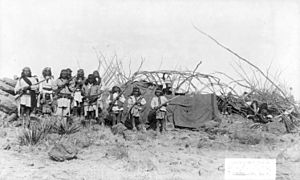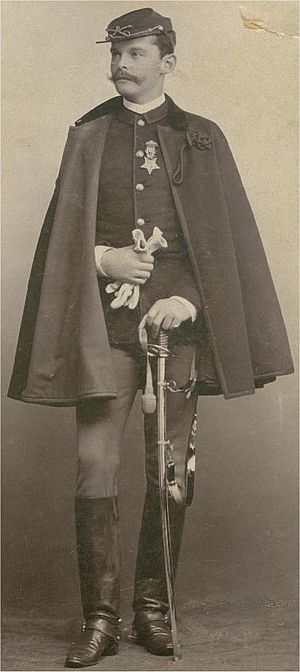Raid on Bear Valley facts for kids

Naiche and his band at Geronimo's camp on March 27, 1886, shortly before their surrender to General George Crook. Geronimo and his followers did not stay in army custody for long and they later escaped, leading to a final surrender at Skeleton Canyon in September 1886. Photograph taken by C. S. Fly.
|
|
| Date | April 27–28, 1886 |
|---|---|
| Location | near Arivaca, Arizona |
| Outcome | 4 killed 1 wounded 1 captured |
The raid on Bear Valley was a conflict that happened in 1886. It was part of Geronimo's War. In late April, a group of Chiricahua Apache people attacked farms and ranches. These were in Santa Cruz County, Arizona. The attacks lasted for two days.
The Apaches raided four cattle ranches in the Bear Valley area. Four settlers died, including a woman and her baby. A young girl was also captured. She was found dead a few days later. The raiders also took or destroyed a lot of property. When the United States Army heard about the attack, they sent soldiers to find the Apaches. In May, two small fights happened in Sonora, Mexico. But the Apaches managed to get away both times.
Contents
The Bear Valley Attack
This attack happened during the last part of the war. Thousands of soldiers and local militia searched for a small group of Chiricahua Apaches. These Apaches were from the San Carlos Reservation. Most of them followed the warrior Geronimo. Other leaders also had their own groups.
After leaving the reservations, the Apaches often went to their safe places. These were in the Sierra Madre mountains of northern Mexico. From there, they would raid Mexican towns. Or they would cross into the United States to raid, like in Bear Valley.
Bear Valley is a large area in southern Arizona. It is just north of the border with Sonora, Mexico. It is also west of Nogales. This made it a good target for Apache raiders from northern Mexico.
Geronimo later said he did not lead this attack. If it wasn't him, it was probably led by Naiche. Naiche was the oldest son of the famous Chief Cochise. However, people said Geronimo was raiding in the area at that time.
First Attack: Peck's Ranch
When the Apaches entered Bear Valley, they first attacked two men. These men were A. L. Peck and his helper, Charles Owen. They were traveling through the desert near Oro Blanco. The attack happened about two miles from Peck's ranch. Owen was shot and killed right away. Peck was taken prisoner.
The Apaches tied Peck to a tree. They guarded him for about an hour. Then they let him go, but without his shoes. Peck ran barefoot back to his home. He found that his house was destroyed. His wife and eleven-month-old baby had been killed. Peck also found that his twelve-year-old niece was gone. She had been captured. She was held by the Apaches until late June 1886. Mexican soldiers rescued her then. She was later reunited with her parents.
Second Attack: Bartlett's Ranch
After the attack on Peck's ranch, the Apaches moved on. They went towards Sycamore Canyon and nearby homesteads. These were about twenty miles south of Arivaca. One of these was the cattle ranch of John "Yank" Bartlett. His partner was Henry "Hank" Hewitt. Their ranch was at the head of the canyon.
On April 28, the day after the Peck ranch attack, a local man visited. His name was Phil Shanahan. His ten-year-old son, Little Phil Shanahan, was staying there. He was with Johnny Bartlett, Yank Bartlett's son. Shanahan decided to ride back to his own ranch. It was a few miles away. He left Little Phil at the Bartlett ranch.
Soon after, the boys heard gunshots in the distance. Then Shanahan stumbled back into view of the ranch house. He said he had been shot. Yank saw the wound and knew Shanahan needed a doctor. He told his son Johnny to ride to Oro Blanco for help. Johnny was also to warn the townspeople. Yank also told Little Phil to go home. He needed to warn his mother and sisters.
Phil made it to his house safely. He took his family into the mountains. They hid there until the next day. While the Shanahans were hiding, the raiders attacked their house. They stole food and clothes. They also killed some cattle.
Not long after Johnny left, he saw three men. Johnny was scared. He turned around and went back. He found that the Apaches had arrived. They were shooting into the house. Johnny rode through the gunfire to the house door. He was not hurt. But his horse was wounded and died in the doorway.
Yank shot back at the Apaches. At the same time, he tried to help Shanahan's wound. Yank was shot in one shoulder. But he stayed awake and kept fighting. When it was dark, Yank sent Johnny out again. He told him to ride to Oro Blanco.
Johnny's Journey
For the first two miles, Johnny walked barefoot. He did this to avoid making too much noise. He reached the ranch of E.W. Smith. Johnny found that the ranch house had been broken into. Black clothes, a gun, and a bottle of brandy were taken. Smith was found soon after. He had probably hidden, or was somewhere else, when the Apaches attacked. Smith joined Johnny. Together they rode to Oro Blanco. They arrived at 2:00 am the next morning. Meanwhile, Yank was able to keep the attackers away. So when Johnny returned with help, the Apaches were already gone.
After the Raid
Both Little Phil Shanahan and Johnny Bartlett were seen as heroes. The people of Santa Cruz County gave them a special rifle for their bravery. Five people died because of the raid. This included Phil Shanahan, who died from his wound. It also included Arthur L. Peck's twelve-year-old niece.
Agua Fria Canyon was later renamed Peck Canyon. Today, the creek near Yank's ranch house is called Yank's Spring. The old foundations of the house are still there. They mark the start of a trail through Sycamore Canyon.
Army Pursuit
When the army learned of the raid, Captain Thomas C. Lebo was sent after the Apaches. He led Troop K of the 10th Cavalry. Captain Lebo found the Apaches' trail near the Bartlett ranch. He tracked the raiders south for over 200 miles. He finally caught up with them on May 3. This was in the Pinito Mountains of Sonora, Mexico.
During the chase, the Buffalo Soldiers counted thirty dead horses. The Apaches had ridden them until they died. A small battle happened. The Apaches shot at the cavalrymen from the top of a steep hill. The first shots killed a private named Hollis. They also wounded a corporal named Scott.
Under heavy fire from the Apaches, Lieutenant Powhatan Clarke saved Corporal Scott. He dragged him to safety. For this brave act, Clarke later received the Medal of Honor. After several hours of fighting, the Apaches went deeper into the Mexican wilderness. They had lost two people killed and one wounded.
Other army units then joined the chase. Captain Charles A.P. Hatfield and Company D, 4th Cavalry, found the Apaches next. This was on May 15. They were camped near the village of Santa Cruz. This was between the Santa Cruz and San Pedro Rivers.
A second fight happened. The cavalry charged and scattered the Apaches. They killed or wounded at least one man. They also captured the Apaches' horses and camping gear. However, shortly after, Hatfield decided to go to the nearby village of Santa Cruz. His group was ambushed five miles from town. They were stopped at a watering hole. Two Americans were killed in this fight. They were a cook and a blacksmith. Two sergeants were wounded. One of them, Samuel Henry Craig, later received the Medal of Honor. He got it for his "conspicuous gallantry" (great bravery). Again, the Apaches got away. They were not captured until the end of the war in September, when Geronimo surrendered.


